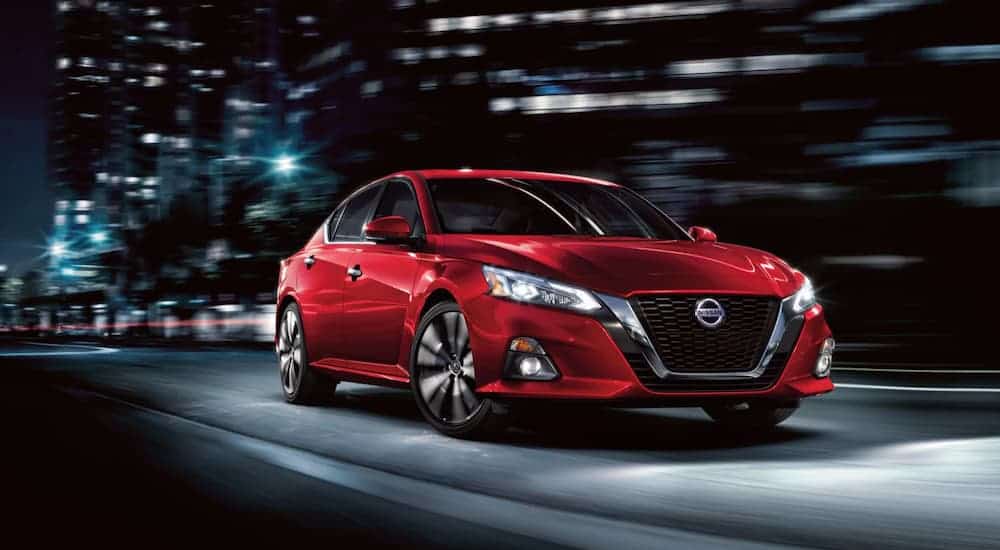Midsize sedans can be for almost every driver, because not every driver wants a massive crossover, and compact cars aren’t roomy enough for most. Considering a midsize sedan is the right move for lots of drivers. And the midsize sedans offered by Nissan and Kia have features and technology that are turning heads even on the base trims. Plus, for a little extra, buyers can go for the upper trim levels and enjoy a wealth of features like heated seats and remote start, along with Apple CarPlay and Android Auto. But between Kia and Nissan, who makes a better midsize sedan? Let’s get more into it by comparing the 2020 Kia Optima vs 2020 Nissan Altima. We are going to look specifically at the highest trims, Optima SX and Altima Platinum, to see which one vehicle has the capability to be the absolute best.
Pricing, Powertrains, Performance
Kia starts the 2020 SX trim at an MSRP of $32,190, with no option for all-wheel drive. Nissan starts the 2020 Platinum trim at an MSRP of $32,180, and intelligent all-wheel drive can be added for a little over $1,000 more. Here, it appears Nissan has a slight lead.
The Optima SX comes standard with a 2.0-liter 4-cylinder turbo engine, which puts out 245 horsepower, and has a six-speed automatic transmission. Gas mileage for this engine is 27 MPG in the city and 37 MPG on the highway. In comparison, the Altima Platinum comes standard with a 2.5-liter 4-cylinder engine, which delivers only 188 horsepower, and has a continuously variable transmission. Additionally, gas mileage for the Platinum is 21 MPG in the city and 30 MPG on the highway. Between the two, the Kia comes out on top for both power and gas mileage.
Exterior

Clearly, Kia is going for a sporty vibe with the Optima SX. The exterior has the bolder grille and beefier front end, with the shark fin antenna and upturned spoiler. The SX offers features such as 18-inch black alloy wheels, a panoramic sunroof with power shade, automatic LED headlights, LED fog lights, power-adjustable heated exterior mirrors with LED turn signal indicators, and memory settings. There is also a rear spoiler, laminated windshield, and front door windows to reduce cabin noise, dual chrome exhaust tips, and smart key technology, which both automatically opens the trunk and lights the side door for night entry.
Nissan’s Altima sticks with styling for the average sedan, though it does have the bolder grille and relatively shapely appearance to accommodate good airflow overall. The Platinum exterior comes loaded with 19-inch aluminum-alloy wheels, automatic LED headlights, LED fog lights, power-adjustable heated exterior mirrors with LED turn signal indicators, and outside mirror memory. There is also a power sliding glass moonroof, an acoustic laminated windshield, an intelligent key system that has remote start and trunk open, and dual chrome exhaust tips.
One significant difference between the two trims in this category is the sporty appearance of the Kia and the difference between a panoramic sunroof with a shade and a moonroof. While the Altima has
Interior
The seating capacity for both vehicles is for five. Nissan has a cargo capacity of 15.4 cubic feet, while the Kia has slightly more at 15.9 cubic feet.
The driver’s seat in the Kia Optima SX offers a 12-way power-adjustable memory seat with powered lumbar support. Front seats are sport leather, heated, and ventilated, and the steering wheel is D-shaped, leather-wrapped, heated, and also tilts and telescopes. Paddle shifters and hands-free phone, audio, and cruise controls are located on the steering wheel. Finishes on the interior are a red two-tone color scheme and a leatherette instrument panel with silver stitching. Between the two vehicle trims, the paddle shifters and shape of the steering wheel are the most noteworthy difference, but the front seats are also ventilated and have more options for comfort controls on the Kia.
Driver seating in the Nissan Altima Platinum is eight-way power-adjustable memory with powered lumbar support. The front seats are leather-appointed and heated, and the steering wheel is leather-wrapped, heated, and tilts and telescopes as well. Platinum also has steering-wheel-mounted audio, hands-free phone, and cruise controls. A piano black and wood tone finish off the interior trim.
Other interior features of the Nissan include dual-zone auto climate control with micro-filter, auto-dimming interior rear-view mirror, folding rear armrest with cup holders, and 60/40 split rear seat. Kia interior features include dual-zone auto climate control with air filters, auto-dimming interior rear-view mirror, folding rear armrest with cup holders, and 60/40 split back seat. An extra feature of the Kia Platinum is the option for driving mode: sport, eco, or comfort. Again, Kia has the edge over Nissan.
Infotainment and Tech Features
With internet connectivity and smartphone use being so prevalent today, car manufacturers are finding the need to offer technology features to stay relevant. When you go with the more expensive trims on any vehicle, the expectation of connectivity and convenience gets even more competitive. How do these sedans stack up against each other? The list of standard features is long, and those who value connectedness should prepare to be pleased.
The Optima SX comes standard with an eight-inch touchscreen, voice-activated navigation, Sirius XM radio, Bluetooth audio streaming, HD radio, Android Auto, Apple CarPlay, Siri Eyes-Free, wireless phone charger, a 10-speaker Harman Kardon surround sound system and rear camera display. Additionally, an auxiliary USB jack allows for streaming from compatible smartphones, three USB ports are added for charging, a 12-volt power outlet is located in the front console, the interior is lit with LED ambient lighting, and the trip computer shows estimated fuel range, odometer, and other features.
The Altima Platinum comes standard with an eight-inch touchscreen, voice-assisted navigation, Sirius XM radio, Bluetooth audio streaming, HD radio, Android Auto, Apple CarPlay, Siri Eyes-Free, nine-speaker Bose audio system, and speed-sensitive volume control. An auxiliary jack allows for streaming from smartphones, two USB and two USB-C ports are provided, and a trip computer displays estimated fuel range, odometer, and other features. The two cars are virtually neck and neck in terms of infotainment. A few slight differences will boil down to buyer preference.
Safety
Now that driver-assisted technology is being considered a must-have in new vehicles, buyers can expect a long list of offerings. Nissan and Kia are taking the challenge seriously, and both the Altima and Optima have plenty of technologies to assist drivers in avoiding unsafe driving conditions. Let’s take a look at how each of these vehicles makes safety a priority.
Kia’s Optima SX incorporates an impressive number of technologies to assist drivers on the road: blind-spot collision warning, parking distance warning, lane change assist, rear cross-traffic collision warning, forward collision warning, forward collision-avoidance with pedestrian detection, lane departure warning, lane-keeping assist, smart cruise control with stop and go feature, electronic parking brake with auto hold, and driver attention warning. All of these features come together to make driving both safer and easier.
Nissan’s Altima Platinum also includes a wide range of driver-assisted features: ProPILOT Assist uses radar technology to automate highway driving, has intelligent forward collision warning, auto emergency braking with pedestrian detection, intelligent lane intervention, blind-spot warning, rear cross-traffic alert, rear sonar system, rear auto braking, vehicle dynamic control with traction control, active ride control, intelligent trace control, hill start assist, auto brake hold, high beam assist, traffic sign recognition, and intelligent driver alertness.
Again, both vehicles are well-equipped for safety, whether backing out of a driveway, pulling out into traffic, avoiding impacts at high speeds, or lessening damage if an impact occurs. But when it comes down to it, there are various features on each of these vehicles that some drivers may want or not want, and those desires will help you decide which car is safer for you.
Kia or Nissan?
Out of the categories that we have compared—pricing, engine, exterior, interior, infotainment, and safety—which vehicle came out on top? In pricing, the match was nearly even, but the 2020 Altima has the option for all-wheel drive. Engine comparison went to the 2020 Optima with more power and better gas mileage. Exterior features leaned more toward Kia’s sportiness and the panoramic sunroof. Interior comfort and convenience definitely went to the Kia with more features in driving mode and the extra convenience of ventilated seats.
Infotainment and Safety were a toss-up, with both vehicles well-matched. Again, some features compared could go to buyer preference, but the 2020 Kia Optima has quite a few overall advantages over the 2020 Nissan Altima and comes out on top.





